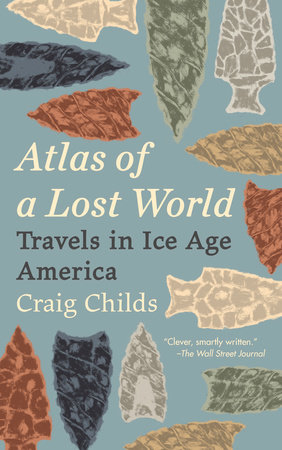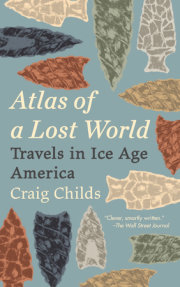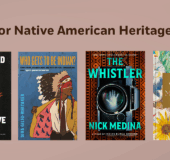PROLOGUE Nothing stirred in the bowels of the earth. Bones lay on bones in silence, a cave sealed shut, its entrance collapsed in the middle of the Pleistocene, the last geologic epoch before our own. Anything stuck inside never got out. The first inkling of new life was the white light of a headlamp and the scratch of small metal tools.
I lay on my side with my hard hat off, working on a camel that had died back here, an awkward place for anything to die, I thought. It was in a crack in the back side of a small chamber, which is why they gave the site to me. I was in my early thirties, base camp cook for a museum crew working on one of the most prolific Pleistocene bone-producing sites in the American West—Porcupine Cave in the mountains of south-central Colorado—churning out rodent bones for the most part, with the occasional hoorah of discovering skeletal cheetah kittens, the toe bones of horses, cores of bison horns. Elsewhere, a dozen excavators and screeners were pulling up a treasure trove of Pleistocene porcupines and squirrels, filling and labeling bags, while I was alone in a hole with
Camelops hesternus
. I imagined the camel crawling into the cave, its hindquarters slashed by sabertooths or hamstrung by dire wolves, trying to save itself, dying here.
When silver miners first blasted into the mountainside in the 1860s, they accidentally clipped one of the cave’s chambers. So they propped up the tunnel with wooden posts and beams. Then they dropped into it with their oil-wick lamps and found passageways, crystals, and domed rooms—floors buried in dust, bones sealed in place three hundred thousand years ago. Now, a ladder brought paleontologists down through the hole the miners opened. They moved through the rotten molasses smell of woodrat urine into the dark, crawling through low spots, pushing gear ahead, headlamps shining on each other’s boot soles. They went to their own trenches and pits, screens and vacuums, setting up grids, fingers picking through countless rodent bones. I went to the camel.
*** “Is it safe for idiots?” I asked.
“None of this is safe for idiots,” said David Stevenson, my friend and mentor, a soul-brother who would turn sixty while we were out on the ice. He said this as we looked across an empty expanse of mountains and glaciers, nothing but rock and whiteness before us.
A mountaineering author and book review editor for the American Alpine Journal, Stevenson was the de facto leader of our group of five heading for the Harding Icefield, one of the largest remaining ice masses in North America. He and I had taken a few quick trips and mountain climbs in the Chugach Range outside his home in Anchorage, finding good company with each other, enough to plan this venture. Stevenson was here to ascend his first nunatak, an Icelandic word for a mountain summit stabbed through ice, a castle of rock completely isolated. It was on his bucket list, and the Harding has plenty. Stevenson and I assembled a small ice- crossing tribe, carrying rope, sleds, skis, and gear on the first load a few thousand feet into the mountains at the edge of the Harding, a giant glacier poured like latex into the crown of the Kenai Mountains. The neck of a ukulele poked out of the top of my pack, gift of a woman we met at the trailhead on the freshly snowed valley floor. None of us knew how to play the instrument, but we brought it anyway. With a pack weight of around eighty pounds each, what’s the difference? Going into the unknown, talismans might come in handy. It was late May. Forty- seven inches of snow had fallen across the Kenai the week before, and ahead lay frozen, treeless earth. I kicked in step after step, counting my breaths under my load, thinking like a Sherpa, or trying to: Fifty steps and rest, fifty steps and rest. I stopped and leaned my weight over my poles, looking up at the two people climbing above me, their shadows flashing against a golden ball of sun, Stevenson breaking a steep, knee-deep trail for the rest of us. I looked down past the other two kicking their way up behind me. The ladder of our tracks disappeared below them, slipping over an edge. Two thousand feet below, a forested valley was melting out of the snow. A glacial river threw question marks across a plain of gray and rocky outwash. I could still make out the road we’d come in on, a meager ribbon to a dead end, a farewell. People once traveled at the speed of two feet, or possibly a paddled boat, but no faster. Most of our evolution was at this pace, one step and the next. The way we zoom around in cars and planes has changed the way we understand the dimensions of geography. Distances are abstract, unapproachable; what you see when you open the shade on an oval window in an airplane and look down thirty thousand feet is walkable land, mesas and mountains appearing ahead, vanishing behind. In the Ice Age, to know about a place was to have been there, or at least heard tell of it. Word of new places came in the form of birds from far away and a different grit to the rivers. We’d left in a window, a swing season. Too early, and you could be pinned down for weeks in late spring whiteouts. Too late, and snow would start melting off the ice, turning its surface into a web of blue-eyed lakes, waterfalls roaring into widening crevasses. This is when you would have gone in the late Pleistocene, a keyhole to slip through. Some Ice Age summers would have been warm enough that meltwater lakes would be forming and bursting across the face of the ice sheet. But most summers would have been frozen solid, nothing but snow accumulation. If we hit it right, a couple thousand feet above here we would drop our sleds, snap into skis, load gear behind us, and strike off like mariners across the Harding. Doing this would require an advanced base camp, where we could leave extra gear and supplies for a round trip. Ice Age people would have done the same, setting a cache for a return. They may have been crazy, but they weren’t idiots.
The first night, we camped on a mountain’s shoulder. Clouds filled the valley, but up here we had a clear sky in the long blue light of an Alaskan evening. A glacier poured a hundred feet below us, its blue-bellied crevasses pillared with snow where it came off the icefield. We clinked cups together, celebrating our first load. The two older guys on the trip, Stevenson and his lifelong climbing buddy, John McInerney, who was fifty-nine, had brought Scotch whiskey. They called it the drink of mountaineers. They added clumps of snow instead of ice and raised a toast to a safe and meaningful journey onto the Harding. I toasted back home to my kids and my wife, their pictures carried in the top of my pack.
*** In New Mexico, we sat in the scrape and bluster of a windstorm, zinc-colored clouds whipping off the evaporated lake around us. We used our backs as shields and ate sausage, cheese, and mayonnaise, our bites gritty with gypsum. We’d left a camp in the dunes and were walking the alkali flats along a high edge of Ancestral Lake Otero. Storm clouds split into ghost fingers through the mountains and streamed over the dead lake.
We weren’t far from Pendejo Cave, a day or two’s walk to this rockshelter in the side of a mesa that would have looked across the south end of the lake. Its name, pendejo, is a bitter curse in Spanish. The cave is a crummy little space, not quite as nice as Paisley Caves, a rough shelter where you could cook or sleep if you had to. Archaeologists thought they’d found a thirty-six-thousand-year-old human artifact here, as well as human skin prints in what had been damp sediment from the same age. Those dates, however, fell through, and scientists now say the oldest human presence at Pendejo appears in flakes and charcoal laid down about thirteen thousand years ago. This puts them in an early Clovis trajectory. A rough day in the field, giant cats out stalking the lake edge hungry for anything, bad weather . . . whatever drove them to this shelter kept them there long enough to leave rock chips and campfires.
On the lakebed, there was no shelter. Jordan was nervous about coming out this far. We were seeing more impact craters and military ephemera, shrapnel and wind-blasted pieces of equipment, though we hadn’t yet seen the fence marking the edge of the missile range. Jordan kept asking who the trip leader was, who was making the decisions. He looked at me as he spoke, and said my name a number of times. I was trying to eat lunch and my eyeballs were sore. I told him we were all out here of our own volition, and it is perfectly legal to traverse the edge of a bombing range on public lands. Jordan said that was fine, he would do anything, he’d jump a fence on the range if necessary, but what, he asked, were we doing, besides sightseeing on a dead lake.
Beyond us was a dead zone, a scattered museum of war history, small parts of vehicles and sequential holes from long-ago strafing runs. Nick found a .50 caliber bullet. He turned it to show the butt, marked where the primer had been hit. The number “43” was imprinted at the edge. His eyes gleamed. “It was made in 1943,” he said.
Meaning, it was from another age. Pre-atomic bomb, before depleted uranium was repurposed into tank-piercing projectiles. Of all of us, Nick was the best historian, having the strongest sense of what is at stake. In this bullet, he held a story from before the Atomic Age, before the world shifted. He knew what modern weapons meant. He’d pulled live bombs out of car trunks, puzzling over their many wires. A trail of blood led into the desert. A body shot through with shrapnel slumped against a steering wheel. He could smell the smoldering around him as he pondered booby traps within booby traps.
This may be why I seek the older stories. I flee to them, crawling into their caves for sanctuary. But I know better. It was no easier thirteen thousand years ago. We live within the same ranges of tension, going as far as we can without snapping regardless of the century or millennia. Bronze Age Ötzi was cut and wounded days before his death, and a flint arrowhead had been shot through his back into his shoulder; he probably bled to death where it cut an artery. Nine-thousand-year-old Kennewick Man in Washington State had a stone projectile embedded in his hip, the wound healed, bone grown over the artifact. A human burial on St. Lawrence Island in the Bering Sea revealed a skeleton pierced by fifteen barbed points made of bone, one skewered clean through the spinal column from behind. These were no easy deaths. If it wasn’t being eaten alive by wild animals, it was someone throwing a spear at you, or maybe many spears. Nick knew this better than any of us.
I told the others to keep their eyes out for anything older than military artifacts, oddities sticking up from the playa, differently colored splotches of ground in a pattern. Mammoths wouldn’t have left much and chances of finding anything in the course of a day’s ramble across emptiness seemed slim. The tracks would be round expressions, like pancakes, or like badly cooked omelets. Ephemeral, washing away, they might be hardly more than discolorations raised an eighth of an inch from the ground.
When we found a trackway, I didn’t know what I was seeing, or which way the mammoth was heading. One splotch, then two, a left-right pattern, some missing, some barely visible, seven prints in total. Jordan no longer cared how far out we were. We’d found something extraordinary.
This had been a Columbian mammoth, the tracks circular, decayed, and toeless. There would be no scientific report on the find. We’d never be able to find these again or explain where they were, compass bearings too vague on this expanse, no GPS to drop a waypoint. I walked alongside the tracks, and the mammoth rose up from the ground, its body filled in by my mind’s eye. It didn’t seem to notice me, it was focused ahead, tusks swaying back and forth as it traveled. It had hair, with rough brownish or gray skin visible underneath, but it was not woolly like its northern cousins, with which this species bred along the northern margins of its territory. This mammoth was a deep continental animal. It may have never seen its smaller woolly cousins.
With proboscideans, you can’t tell by a simple track which way it was heading without seeing its toes. Nor can you tell how fast it was moving, elephants having only one gait, no sprint or gallop. All I could tell is that a mammoth had been here—this mammoth had been here. The tracks would have connected to trails coming in from the Jornada and from the mesas to the south. If they were anything like modern elephants, mammoths reused old routes, pounding them deeply into the ground. You would have seen their trails coming and going from all directions to this lake.
Mammoth tracks have also been found along a former lakeshore in Alberta, documented in fine-enough detail that researchers have been able to determine the population dynamics. Known as Wally’s Beach, the site indicates a declining mammoth population at the end of the Pleistocene. The Alberta tracks show the same herd demographics of African elephants that have been battered by poaching and drought, the adults more numerous than juveniles. In a healthy African herd, juveniles represent 60 percent of individuals. A declining herd is 30 percent juveniles. That is what is seen at Wally’s Beach. By the end of the Ice Age, mammoths were on their way out. There have been at least nine ice ages over the last seven hundred thousand years. The mammoths were weakened each time one ended, but they survived and rebounded to face the next go-round. This time they did not make it. For them, the last Ice Age was the end.
After the seventh track, the prints washed away. The mammoth kept going, walking until it was only a space in the air. I felt as if I were the one retreating, the one left behind as the mammoth lumbered into nothing.
Charlotte dropped to her knees about twenty feet from the tracks and pushed both hands firmly into the earth, giving an extra heave with her shoulders. She made two perfect handprints and scrawled the year of our arrival next to them, prints that would vanish in the next storm. This was our story. One geologic era later, mammoth hunters had found their quarry.
Copyright © 2018 by Craig Childs. All rights reserved. No part of this excerpt may be reproduced or reprinted without permission in writing from the publisher.







